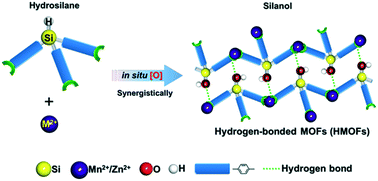In situ selective ligand transformation from Si–H to Si–OH for synergistic assembly of hydrogen-bonded metal–organic frameworks†
Abstract
Based on a new tripodal hydrosilane ligand, two isoreticular metal–organic frameworks (MOFs) have been synthesized by in situ selective transformation of the ligand from hydrosilane to silanol. Control experiments have been carried out to study the synthetic mechanism and demonstrate that the initially formed coordination clusters facilitate the in situ ligand oxidation, and synergistically the oxidized silanol ligands serving as hydrogen-bond donors impel the assembly of the specific hydrogen-bonded 2D MOFs (HMOFs). SiMOF-2 manifests a high CO2 sorption of 55.5 cm3 g−1 at 273 K.



 Please wait while we load your content...
Please wait while we load your content...